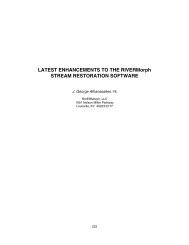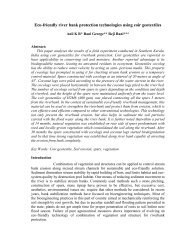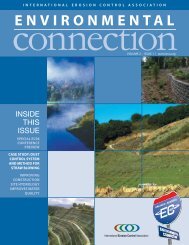ENVIRONMENTAL - International Erosion Control Association
ENVIRONMENTAL - International Erosion Control Association
ENVIRONMENTAL - International Erosion Control Association
You also want an ePaper? Increase the reach of your titles
YUMPU automatically turns print PDFs into web optimized ePapers that Google loves.
PEER<br />
review<br />
Case Study:<br />
Maho Bay Watershed Road <strong>Erosion</strong><br />
Reduction Project, St. John, USVI<br />
By Carlos E. Ramos-Scharron, PhD<br />
Increased sediment delivery associated with land development and unpaved roads is a key stressor of nearshore coral reef<br />
systems in the U.S. Virgin Islands. This article briefl y describes eff orts to reduce sediment production rates from an unpaved<br />
road segment in the island of St. John, USVI. Five insloped cemented swales and a paved ditch were built along a 230 m<br />
long road segment to reduce the forces applied by fl owing water on the road surface. The method proved to be eff ective as<br />
sediment production data collected with a sediment trap showed that post-treatment erosion rates were only 30 percent of<br />
pre-treatment levels.<br />
The increased rate of sediment delivery<br />
that typically accompanies<br />
land development is one of the<br />
greatest stressors threatening the coral<br />
reef systems of the U.S. Virgin Islands.<br />
Previous studies conducted on St. John-<br />
USVI have identified the unpaved road<br />
network as the most important source<br />
of sediment on the island [1,2] . These<br />
studies indicate that unpaved roads<br />
erode at rates that may be up to 10,000<br />
times higher than undisturbed hillslopes<br />
[3,4] , and that sediment delivery<br />
into coastal waters from watersheds<br />
containing unpaved roads are 300–900<br />
percent higher than from undisturbed<br />
watersheds [5,6] .<br />
An important goal of erosion studies<br />
conducted between 1992 and 2001 by<br />
Colorado State University (CSU) and<br />
Island Resources Foundation (IRF) in<br />
St. John was to provide guidance for<br />
public and private agencies, as well as<br />
local communities, in the development<br />
and application of sediment control<br />
strategies. Between 1999 and 2003 we<br />
collaborated with the VI-Department<br />
of Planning and Natural Resources<br />
(VI-DPNR), VI National Park, and<br />
homeowner associations in the development<br />
and application of strategies<br />
to reduce sediment loading rates into<br />
several bays on St. John. An evaluation<br />
of these efforts was performed with the<br />
GIS-based STJ-EROS model [7] , and it<br />
concluded that erosion control projects<br />
reduced watershed-scale sediment load<br />
rates by 24, 36, and 5 tons per year into<br />
Lameshur Bay, Fish Bay, and Cinnamon<br />
Bay, respectively. These reductions<br />
represented a 10–45 percent drop in<br />
sediment yields relative to rates preceding<br />
the implementation of the erosion<br />
control projects. Within some of these<br />
watersheds, sediment yields have continued<br />
to increase in spite of these efforts<br />
as the unpaved road network continues<br />
to grow.<br />
The Maho Bay Watershed <strong>Erosion</strong><br />
Reduction Project was a derivation of<br />
CSU’s and IRF’s efforts to actively participate<br />
in locally-based erosion control<br />
efforts. The road providing access to the<br />
Maho Bay Camps (hereafter referred to<br />
as Maho-Road) (Figure 1) was selected<br />
as an adequate site for an erosion control<br />
demonstration project for several<br />
reasons. First, for many years managers<br />
and maintenance crews at Maho Bay<br />
Camps puzzled at trying to develop a<br />
cost-effective strategy to reduce erosion<br />
along Maho-Road. Maintaining<br />
a drivable surface on Maho-Road was<br />
very difficult, particularly during the<br />
rainy season, as it tended to suffer severe<br />
rilling damage during intense rain<br />
events (Figure 2). Secondly, previous<br />
field data identified Maho-Road as an<br />
erosion ‘hot-spot,’ because observed<br />
sediment production rates from Maho-<br />
Road were higher than most other road<br />
segments being monitored as part of<br />
those studies.<br />
Maho-Road also was visited by<br />
community members and government<br />
employees representing both territorial<br />
and federal agencies during a 1999 University<br />
of the Virgin Islands Water Resources<br />
Research Institute special seminar<br />
directed by this author. Seminar<br />
participants observed the approximately<br />
27 m 3 of sediment that had accumulated<br />
on a silt-fence used for monitoring<br />
sediment production from Maho-Road<br />
over the previous two years. This visual<br />
corroboration of the volume of<br />
sediment that was being produced by<br />
18 • <strong>ENVIRONMENTAL</strong> CONNECTION













